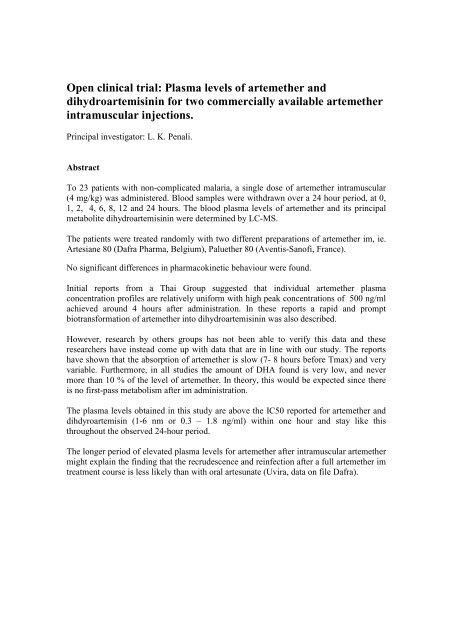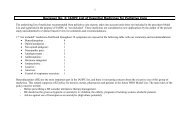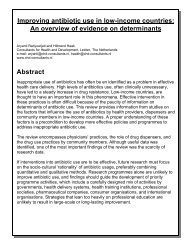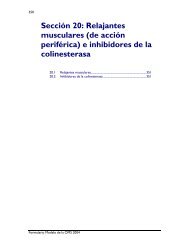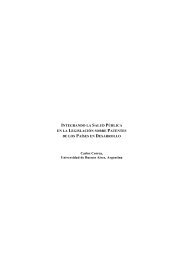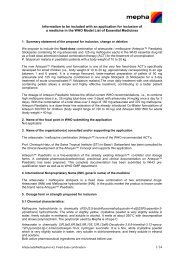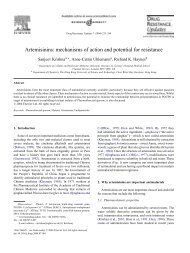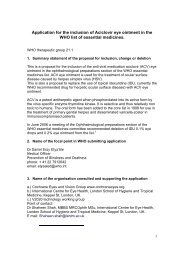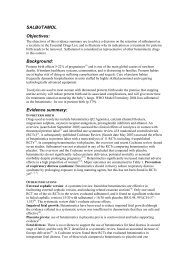FINAL report Penali artemether im. pharmacokinetics
FINAL report Penali artemether im. pharmacokinetics
FINAL report Penali artemether im. pharmacokinetics
You also want an ePaper? Increase the reach of your titles
YUMPU automatically turns print PDFs into web optimized ePapers that Google loves.
Open clinical trial: Plasma levels of <strong>artemether</strong> and<br />
dihydroartemisinin for two commercially available <strong>artemether</strong><br />
intramuscular injections.<br />
Principal investigator: L. K. <strong>Penali</strong>.<br />
Abstract<br />
To 23 patients with non-complicated malaria, a single dose of <strong>artemether</strong> intramuscular<br />
(4 mg/kg) was administered. Blood samples were withdrawn over a 24 hour period, at 0,<br />
1, 2, 4, 6, 8, 12 and 24 hours. The blood plasma levels of <strong>artemether</strong> and its principal<br />
metabolite dihydroartemisinin were determined by LC-MS.<br />
The patients were treated randomly with two different preparations of <strong>artemether</strong> <strong>im</strong>, ie.<br />
Artesiane 80 (Dafra Pharma, Belgium), Paluether 80 (Aventis-Sanofi, France).<br />
No significant differences in pharmacokinetic behaviour were found.<br />
Initial <strong>report</strong>s from a Thai Group suggested that individual <strong>artemether</strong> plasma<br />
concentration profiles are relatively uniform with high peak concentrations of 500 ng/ml<br />
achieved around 4 hours after administration. In these <strong>report</strong>s a rapid and prompt<br />
biotransformation of <strong>artemether</strong> into dihydroartemisinin was also described.<br />
However, research by others groups has not been able to verify this data and these<br />
researchers have instead come up with data that are in line with our study. The <strong>report</strong>s<br />
have shown that the absorption of <strong>artemether</strong> is slow (7- 8 hours before Tmax) and very<br />
variable. Furthermore, in all studies the amount of DHA found is very low, and never<br />
more than 10 % of the level of <strong>artemether</strong>. In theory, this would be expected since there<br />
is no first-pass metabolism after <strong>im</strong> administration.<br />
The plasma levels obtained in this study are above the IC50 <strong>report</strong>ed for <strong>artemether</strong> and<br />
dihdyroartemisin (1-6 nm or 0.3 – 1.8 ng/ml) within one hour and stay like this<br />
throughout the observed 24-hour period.<br />
The longer period of elevated plasma levels for <strong>artemether</strong> after intramuscular <strong>artemether</strong><br />
might explain the finding that the recrudescence and reinfection after a full <strong>artemether</strong> <strong>im</strong><br />
treatment course is less likely than with oral artesunate (Uvira, data on file Dafra).
Study Site: Anonkoua-Kouté (Abidjan), Ivory Coast.<br />
Exper<strong>im</strong>ental Procedure: Open Controlled Clinical Trial<br />
Principal Investigator: Dr. O. André Touré<br />
Study Director Dr L. Koné PENALI<br />
Co-Investigators: Dr E. W. BEUGRE<br />
Dr AKA WOGNIN<br />
Data Management and Analysis: Mr T. SERY<br />
Sponsor: DAFRA PHARMA<br />
Pharmaceutical Support: DAFRA PHARMA<br />
External Monitor: F. Herwig Jansen, M.D., Ph.D.<br />
Fhj@dafra.be<br />
Start of the study: July 2004<br />
Duration of study: 1 month<br />
Number of patients included: 23<br />
Collaborating Institutions:<br />
a) UNITE DE PALUDOLOGIE- INSTITUT PASTEUR D’ABIDJAN<br />
01 BP 490 ABIDJAN 01 – COTE D’IVOIRE<br />
b) DAFRA PHARMA<br />
Steenweg op Mol 148<br />
2360 Oud-Turnhout<br />
Tel. ++/32/14/61 78 20<br />
Fax ++/32/14/61 78 59<br />
E-mail: info@dafra.be; Fhj@dafra.be<br />
1
1. INTRODUCTION<br />
Artemether, an artemisinin derivative, is available in various formulations suitable for the<br />
treatment of complicated and non-complicated malaria.<br />
We decided to study if there is a difference in plasmalevels of the active compounds of<br />
two commercially available intramuscular <strong>artemether</strong> injections and to compare the<br />
results with literature. Since the available literature data is pr<strong>im</strong>arily based on research on<br />
Asian subjects, with this new study we could generate data in an African population.<br />
The two products used were Artesiane (<strong>artemether</strong> in miglyol) from Dafra and Paluether<br />
(<strong>artemether</strong> in arachis oil) from Aventis-Sanofi.<br />
Next to the present study, we studied the clinical efficacy and tolerability of the Artesiane<br />
i.m. injection in the treatment of non-complicated malaria with 30 subjects. This study<br />
will be <strong>report</strong>ed separately.<br />
2. OBJECTIVES<br />
2. 1. Principal Objective<br />
To determine the plasma levels of <strong>artemether</strong> and dihydroartemisin after administration<br />
of an <strong>artemether</strong> injection in a single dose of 4 mg/kg in patients with non-complicated<br />
malaria.<br />
2. 2. Secondary Objectives<br />
- none<br />
3. METHODOLOGY<br />
3.1. Study Site: The study site is Anonkoua-Kouté. Ivory Coast is a country located in<br />
West Africa. Malaria is endemic (hypo- to hyperendemic), but great variation exists<br />
according to the area. Malaria transmission is mainly seasonal and most of the<br />
transmission occurs during the rainy season.<br />
Anonkoua-Kouté is a peri urban area of Abidjan, the capital city of Ivory Coast. P.<br />
falciparum is a predominant species, accounting for more than 95% of malaria cases.<br />
2
3.2. Study Period: The study was done in July 2004 during the rainy season.<br />
3.3. Study Design:<br />
The study was an open study. The plasma levels for <strong>artemether</strong> and its principal<br />
metabolite dihydroartemisinin were determined.<br />
3. 4. Target Population: Subjects living in the study area and aged from 16 years or<br />
more, with an acute uncomplicated P. falciparum malaria.<br />
3. 5. Inclusion and Exclusion Criteria<br />
3.5.1. Inclusion criteria:<br />
- Age ≥ 16 years<br />
- Weight ≥ 35 kg<br />
- To be a resident of Anonkoua-kouté during the study period.<br />
- Axillary temperature ≥ 37,5 °C or <strong>report</strong> of fever within the last 24 hours.<br />
- Monospecific infection with P. falciparum between 1000 and 100 000/µL blood.<br />
- Declaration of informed consent or permission from participant or parents/guardians for<br />
minors.<br />
3.5.2. Exclusion criteria:<br />
- Presence of severe or complicated malaria (according to the WHO 2000).<br />
- Presence of severe concommittant illness or any other illness that required a treatment<br />
non-compatible with this study.<br />
- Allergy to study drugs<br />
- Pregnancy (detected clinically, or with β HCG test)<br />
- Use of any component of the study drugs within the last 28 days prior to the inclusion.<br />
3. 6. Sample Size: 23 patients were included.<br />
3
3. 7. Data Collection Methods: Data were collected directly into the Case Report Form<br />
(CRF) for clinical information. For laboratory exams, data were recorded in Source<br />
documents and then recorded into the CRF later.<br />
3.8. Study Products: Artesiane ® <strong>im</strong> injection was a gift from Dafra pharma in Belgium.<br />
It contains 80 mg/ml <strong>artemether</strong> in miglyol. Paluether ® <strong>im</strong> injection was bought in<br />
Abidjan. It contains 80 mg/ml <strong>artemether</strong> in arachis oil.<br />
3. 9. Treatment Procedure: All treatments were administered to the study site’s health<br />
center by the investigator. Artemether was administrated as 4 mg/kg at t<strong>im</strong>e 0, in a single<br />
injection in the outer upper quadrant fo the quadriceps muscle.<br />
3.10 Sample storage and shipping<br />
Immediately after collection, the samples were centrifuged and the plasma fraction<br />
refrigerated at - 20 °C. At the end of the study all samples were packed and transported<br />
by special refrigerated air freight to Belgium. Upon receipt in Belgium, the samples were<br />
stored at - 20 °C, until the t<strong>im</strong>e of analysis.<br />
3.11 Analysis of plasma levels by LC-MS<br />
A sensitive and selective method was developed for the determination of <strong>artemether</strong> and<br />
its active dihydroartemisinin metabolite in human plasma using artemisinin as internal<br />
standard.The method consists of a liquid–liquid extraction with subsequent evaporation<br />
of the supernatant to dryness followed by the analysis of the reconstituted sample by<br />
liquid chromatography–mass spectrometry (LC–MS) in single ion monitoring mode<br />
using atmospheric pressure chemical ionization (APCI) as an interface. Chromatography<br />
was performed on a C18 column using gradient mixtures of water-formic acid 0.1 % (A)<br />
& acetonitrile–formic acid 0.1% (B) as mobile phases.<br />
4
The gradient scheme is presented below:<br />
0 - 8 min<br />
8 -10 min<br />
10 -16 min<br />
16 - 18 min<br />
18-30<br />
45:55 = A: B<br />
45:55 = A:B → 100 B<br />
100 B<br />
100 B → 45:55 = A:B<br />
45:55 = A:B<br />
The method was validated over a concentration range of 5–200 ng/ml using 1.0 ml of<br />
human plasma per assay. The method was applied to the quantification of <strong>artemether</strong> and<br />
its metabolite in human plasma.<br />
The quantity of <strong>artemether</strong> and DHA is calculated in relation to the internal artemisinin<br />
standard.<br />
Sample preparation:<br />
To 1 ml of a plasma sample 20 µl of internal artemisinin standard solution ( 10 µg/ml<br />
artemisinin) was added, followed by 0.5 ml of a satured NaCl-solution. The sample is<br />
vortexed and extracted with 5 ml isooctane/ethylacetate 7/3. The complete sample is<br />
vortexed for 1 minute. The samples are centrifuged at 2000 rpm for 5 minutes. The upper<br />
phase is transferred into a second sample tube and evaporated. The residue is dissolved in<br />
200 µl mobile phase (45/55 water-formic acid 0.1 % : acetonitrile–formic acid 0.1%)<br />
5
3.12. Data Management, Quality Assurance and Quality Control:<br />
All of the study personnel was trained in GCPs (Good Clinical Practices) and GLPs<br />
(Good Laboratory Practicies) with respect for conducting the study according to the<br />
protocol and the principles of ethics.<br />
Data were collected on standardized data collection forms and standard laboratory<br />
notebooks. At the end of the day, lab and clinical personnel checked the completeness,<br />
readability range and consistency of the data in the recorded forms and corrected them if<br />
necessary. The study was monitored on regular basis by senior investigators.<br />
3.13. Ethical Considerations: Institutional Ethical Committee of Dafra and of the<br />
Pasteur Institute, Abidjan, Ivory Coast approved the protocol and the consent form.<br />
Individual written consent were obtained from all participants or parents/legal guardians<br />
(for minors) prior to the inclusion.<br />
6
4. RESULTS<br />
4.1 Baseline patient characteristics at t<strong>im</strong>e of admittance.<br />
Artesiane:<br />
Patient number Sexe Age (years) Parasitemia ( / µl blood)<br />
1 F 16 2000<br />
2 F 35 5280<br />
5 F 21 3280<br />
12 M 25 2560<br />
13 F 22 4160<br />
17 M 16 10720<br />
18 F 20 8160<br />
19 M 31 6280<br />
21 M 26 2560<br />
22 F 32 2800<br />
23 F 30 3760<br />
Range 7 F – 4 M 16 - 35 2560 - 10720<br />
Average 25 ± 7 4687 ± 2726<br />
Paluether<br />
Patient number Sexe Age (years) Parasitemia ( / µl blood)<br />
3 F 16 31360<br />
4 F 18 14240<br />
8 F 32 56880<br />
9 F 16 12240<br />
10 F 37 6640<br />
11 M 30 5120<br />
15 M 17 7680<br />
16 F 31 2160<br />
20 F 26 5600<br />
Range 7 F – 2 M 16 - 37 2160 - 56880<br />
Average ± SD 25 ± 8 15769 ± 17673<br />
Patients 6 & 7 whom were given artesiane 80 did not show up anymore after drug<br />
administration. Patient 14, whom was given paluether, was excluded later on, because the<br />
parasitemia was higher than 100.000.<br />
Between the two groups the age and sexe-distribution were s<strong>im</strong>ilar. The parasite count in<br />
the group receiving paluether was higher. (two sample t-test= 0.05)<br />
7
4.2. Plasma levels of individual patients<br />
The determined plasma levels of <strong>artemether</strong> obtained with the two different formulations<br />
are presented in the following 2 graphs. The plasma levels of dihydroartemisin stayed<br />
very low throughout the study and are not displayed separately.<br />
plasma levels (ng/ml)<br />
plasma levels (ng/ml)<br />
140<br />
120<br />
100<br />
140<br />
120<br />
100<br />
80<br />
60<br />
40<br />
20<br />
80<br />
60<br />
40<br />
20<br />
Artemether plasma levels vs t<strong>im</strong>e for Artesiane<br />
0<br />
0 4 8 12 16 20 24<br />
T<strong>im</strong>e (hours)<br />
Artemether plasmalevels vs t<strong>im</strong>e for Paluether<br />
0<br />
0 4 8 12 16 20 24<br />
t<strong>im</strong>e (hours)<br />
1<br />
2<br />
3<br />
4<br />
5<br />
6<br />
7<br />
8<br />
9<br />
10<br />
11<br />
1<br />
2<br />
3<br />
4<br />
5<br />
6<br />
7<br />
8<br />
9<br />
8
4.3. Average plasma levels<br />
A graph of the average plasma levels of both formula’s is given below. Furthermore the<br />
results are presented in tabulated format.<br />
plasma (ng/ml)<br />
70,0<br />
60,0<br />
50,0<br />
40,0<br />
30,0<br />
20,0<br />
10,0<br />
Average plasma levels <strong>artemether</strong> (arm) and dihydroartemisinin (DHA )<br />
vs t<strong>im</strong>e for Artesiane and Paluether<br />
0,0<br />
0 4 8 12 16 20 24<br />
t<strong>im</strong>e (hours)<br />
Table: Plasma levels of <strong>artemether</strong> and dihydroartemisin (± SD)<br />
Artesiane ® Paluether ®<br />
T<strong>im</strong>epoint<br />
Artemether DHA (ng/ml) Artemether<br />
(ng/ml)<br />
(ng/ml)<br />
t = 0<br />
0.0<br />
0.0<br />
0.0<br />
t = 1<br />
10.6 ± 5.5<br />
0.0 11.8 ± 8.2<br />
t = 2<br />
20.9 ± 12.9<br />
0.0 14.0 ± 10.8<br />
t = 4<br />
28.9 ± 23.6 2.3 ± 7.7 24.1 ± 11.6<br />
t = 6<br />
34.8 ± 24.5 3.7 ± 9.1 38.3 ± 24.6<br />
t = 8<br />
53.7 ± 37.5 6.9 ± 13.1 47.4 ± 38.1<br />
t = 12<br />
59.8 ± 34.9 7.1 ± 13.4 47.8 ± 37.7<br />
t = 24<br />
42.2 ± 16.7 6.1 ± 10.6 31.9 ± 14.6<br />
The graph and the table indicate that the two formulations give a s<strong>im</strong>ilar result.<br />
arm artesiane<br />
dha artesiane<br />
arm paluether<br />
dha paluether<br />
DHA (ng/ml)<br />
0.0<br />
0.0<br />
0.0<br />
0.0<br />
2.4 ± 4.7<br />
3.3 ± 6.6<br />
1.6 ± 4.9<br />
3.4 ± 6.9<br />
9
4.4. Tmax<br />
The Tmax for both formulations is around 12 hours, but due to the l<strong>im</strong>ited amount of<br />
sampling points it can not be excluded that the real Tmax is slightly later.<br />
4.5 Cmax<br />
The Cmax for <strong>artemether</strong> and its metabolite dihydroartemisinin for both formula’s are<br />
presented in the table below:<br />
Preparation C max (µg/ml)<br />
Artesiane<br />
Artemether: 59.8 ( 18 – 128)<br />
DHA: 7 ( 0 – 40)<br />
Paluether Artemether: 47.8 ( 14 – 128)<br />
DHA: 3 ( 0 – 18)<br />
The table shows that the Cmax is comparable.<br />
5. Discussion and conclusion<br />
To 23 patients, suffering from non-complicated malaria, a single dose of <strong>artemether</strong><br />
intramuscular (4 mg/kg) was administered. Blood sampling was done at 0, 1, 2 4, 6, 8, 12<br />
and 24 hours. The plasma levels of <strong>artemether</strong> and its principal metabolite<br />
dihydroartemisinin were determined by LC-MS.<br />
Summarizing, in this trial no differences were observed between the two formulations.<br />
Initial <strong>report</strong>s from a Thai Group (Karbwang, 1997 & 1998) suggested that individual<br />
<strong>artemether</strong> plasma concentration profiles are relatively uniform with high peak<br />
concentrations of 500 ng/ml achieved around 4 hours after administration. In these<br />
<strong>report</strong>s a rapid and prompt biotransformation of <strong>artemether</strong> into dihydroartemisinin was<br />
also described.<br />
However, research by others groups (Silamut, 2002; Mithwani, 2003; Teja-Isavadharm,<br />
1996) has not been able to verify this data and has instead come up with data that are in<br />
line with our study. The <strong>report</strong>s showed that the absorption of <strong>artemether</strong> is slow (7- 8<br />
hours before Tmax) and very variable. Furthermore in all studies the amount of DHA<br />
found is very low, and never more than 10 % of the level of <strong>artemether</strong>. In theory, this<br />
would be expected since there is no first-pass metabolism after i.m. administration.<br />
10
The plasma levels obtained in this study are above the IC50 <strong>report</strong>ed for <strong>artemether</strong> and<br />
dihdyroartemisin (1-6 nm or 0.3 – 1.8 ng/ml) within an hour and stay like this throughout<br />
the observed 24-hour period.<br />
The longer period of elevated plasma levels of <strong>artemether</strong> after intramuscular <strong>artemether</strong><br />
might explain the finding that the recrudescence and reinfection after a full <strong>artemether</strong> <strong>im</strong><br />
treatment course is less likely than with oral artesunate (Uvira, data on file Dafra)<br />
Although the carrier oil in which the <strong>artemether</strong> is dissolved for both commercial<br />
formulations is different, miglyol or arachis oil, no difference in plasma levels of<br />
<strong>artemether</strong> were detected. This indicated that most propably that <strong>artemether</strong> itself is the<br />
l<strong>im</strong>iting factor in absorption from the site of injection and not the formulation. This is in<br />
contrast with arteether where it was suggested that the sesame oil used in the formula<br />
makes that tmax is extended (Looareesuwan, 2002)<br />
Summarizing, the present study confirms the findings obtained in Asia in African adults.<br />
6. ACKNOWLEDGMENTS<br />
We thank the people of Anounkoua- Kouté for their cooperation, the Pasteur institute in<br />
Abidjan for developing the protocol, providing the team and also for technical support.<br />
We are grateful to Dafra Pharma, Belgium for providing the drugs, financial and<br />
technical support.<br />
7. LITERATURE CITED<br />
Alin et al (1990) In vitro activity of artemisinin, its derivatives and pyronaridine against<br />
different strains of Plasmodium falciparum. Trans. R. Soc. Trop. Med 84, 635-637.<br />
Dai. et al (1994) A comparative study of <strong>artemether</strong> injection and artesunate tablets in<br />
P.falciparum malaria patients in Vietnam. In house <strong>report</strong> Dafra Pharma ltd.<br />
Huda et al (2003) A comparative trial of <strong>artemether</strong> and quinine in children with severe<br />
malaria. Downloaded from www. Indianpediatrics.net on 16-01-2004.<br />
Karbwang et al (1997) Pharmacokinetics and bioavailability of oral and intramuscular<br />
<strong>artemether</strong>. Eur. J. Clin. Pharmacol 52, 307-310<br />
Karbwang et al (1998) Pharmacokinetics of intramuscular <strong>artemether</strong> in patients with<br />
severe falciparum malaria with or without acute renal failure. Br. J. Clin. Pharmacol 45,<br />
597-602.<br />
11
Looareesuwan et al (2002) Dose-finding and efficacy study for i.m. artemotil (betaarteether)<br />
and comparison with i.m. <strong>artemether</strong> in acute uncomplicated P. falciparum<br />
malaria. Br.J.Clin.Pharmacol. 53, 492-500.<br />
Mithwani et al (2003) Population <strong>pharmacokinetics</strong> of <strong>artemether</strong> and dihydroartemisinin<br />
following single intramuscular dosing of <strong>artemether</strong> in African children with severe<br />
falciparum malaria. Br. J. Clin. Pharmacol. 57, 146-152<br />
Silamut et al (2003) Artemether bioavailability after oral or intramuscular administration<br />
in uncomplicated falciparum malaria. Ant<strong>im</strong>icrob. Agents Chemother. 47, 3795-3798.<br />
Souppart et al (2002) Development and validation of a high-performance liquid<br />
chromatography-mass spectrometry assay for the determination of <strong>artemether</strong> and its<br />
metabolite dihydroartemisinin in human plasma. J. Chromatogr. B. Analyt Technol<br />
Biomed Life Sci 774, 195-203.<br />
Teja-Isavadharm et al (1996) Comparative bioavailability of oral, rectal, and<br />
intramuscular <strong>artemether</strong> in healthy subjects: use of s<strong>im</strong>ultaneous measurement by high<br />
performance liquid chromatography and bioassay. Br. J. Clin. Pharmacol. 42, 599-604.<br />
Taylor et al (1998) Intramuscular <strong>artemether</strong> vs intravenous quinine: an open randomized<br />
trial in Malawian children with cerebral malaria. Trop.M. Int. Health. 3, 3-8.<br />
12


